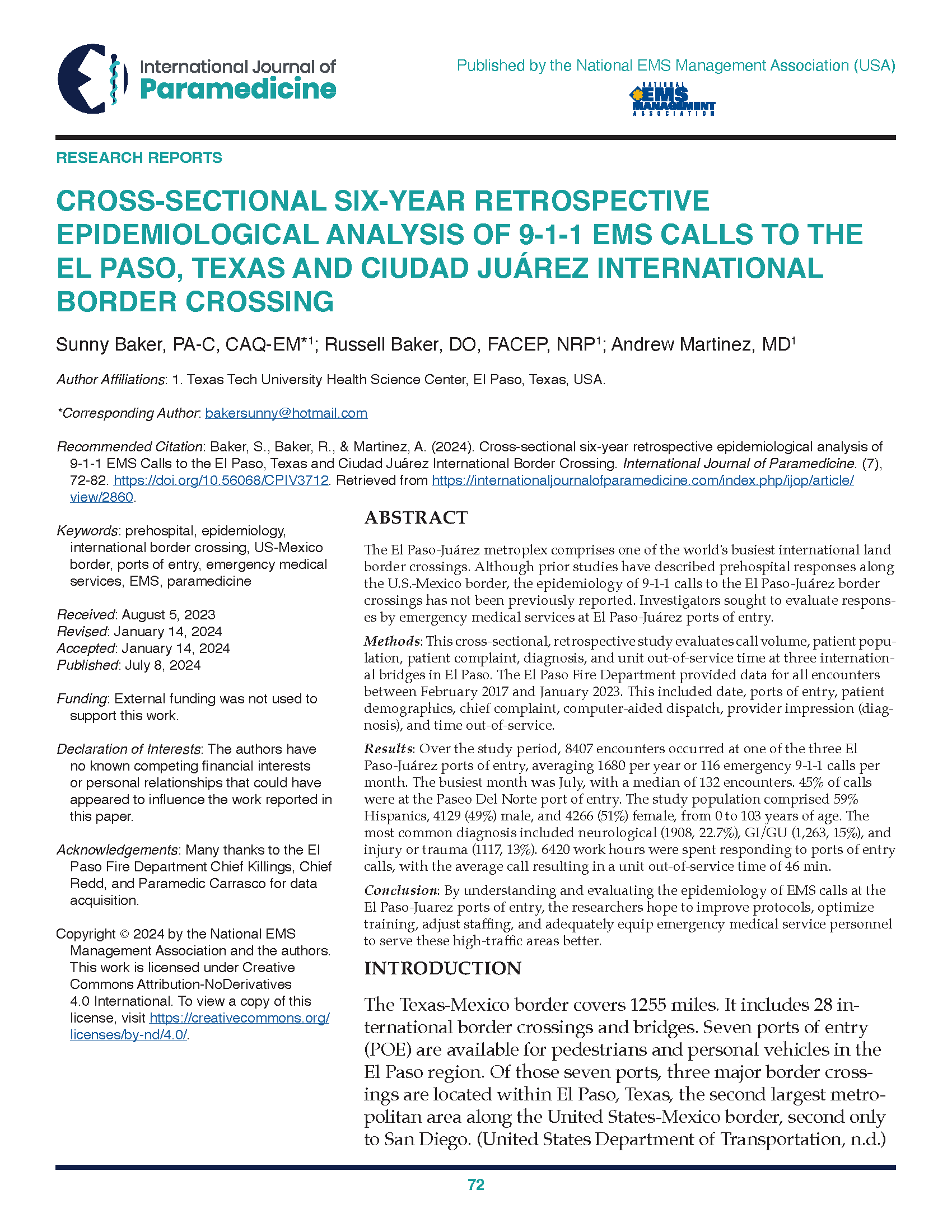Cross-Sectional Retrospective Epidemiological Study of 9-1-1 Calls to the El Paso, Texas, and Ciudad Juárez International Border Crossing
Main Article Content
Abstract
The El Paso-Juárez metroplex comprises one of the world's busiest international land border crossings. Although prior studies have described prehospital care along the US-Mexico border, the epidemiology of 9-1-1 calls to the El Paso-Juárez border crossings has not been previously reported. Investigators sought to evaluate responses by emergency medical services (EMS) at El Paso-Juárez ports of entry (POE). Methods: This cross-sectional, retrospective study evaluates prehospital care provided by EMS at three international bridges in El Paso. The El Paso Fire Department (EPFD) provided data for all encounters between February 2017 and January 2023. This included date, POE, patient demographics, chief complaint, computer-aided dispatch (CAD), provider impression (diagnosis), and time out of service. Results: Over the study period, 8,407 encounters occurred at one of the three El Paso-Juárez POE, averaging 1,680 per year or 140 calls per month. The busiest month was July, with a median of 132 encounters. 45% of these calls took place at the Paseo Del Norte POE. The study population comprised 59% Hispanics, 4129 (49%) male, and 4266 (51%) female, from 0 to 103 years of age. The most common diagnosis was neurological (1,908, 22.7%), GI/GU (1,263, 15%), and injury or trauma (1117, 13%). 6,420 hours were spent responding to POE calls, the average call resulting in a 46-minute out-of-service time. Conclusion: This was the first study to investigate the epidemiology of prehospital care provided by EMS at the El Paso-Juárez international border crossing. A total of 8,407 prehospital EMS encounters occurred over the study period, which is expected to grow. We found roughly equal proportions of male and female patients with a wide range of ages. The most common diagnoses were weakness, abdominal pain, and non-traumatic pain. The results of this study could be utilized to enhance the quality of EMS offered at international border crossings.
Article Details

This work is licensed under a Creative Commons Attribution-NoDerivatives 4.0 International License.
Publishing in IJOP allows authors to keep their copyright while giving IJOP unrestricted copyright permissions. Articles published in IJOP use Creative Common Attribution 4.0 International (CC BY-ND 4.0) licensing. This license requires that re-users give credit to the creator. It allows re-users to copy and distribute the material in any medium or format in unadapted form only, even for commercial purposes. Additional terms apply and can be accessed here.
Publishing in IJOP also allows authors to have contracts for non-exclusive distribution of the Journal's published version of the article, such as posting to an institutional repository or publication in a book, on the condition that the original publication in the original layout format in IJOP is retained and acknowledged.
We permit and encourage authors to post the articles they published in IJOP on their affiliated websites. This helps share the information, encourages citation in other works, and promotes scholarly discourse in the spirit of open access.
References
Agudelo Higuita, N. I., Franco-Paredes, C., Henao-Martínez, A. F., Mendez Rojas, B., Suarez, J. A., Naranjo, L., & Alger, J. (2023). Migrants in transit across Central America and the potential spread of chloroquine-resistant malaria–a call for action. The Lancet Regional Health - Americas, 22, 100505. https://doi.org/10.1016/j.lana.2023.100505
Baker, R. A. (2017). Border injuries: An analysis of prehospital demographics, mechanisms, and patterns of injuries encountered by USBP EMS agents in the El Paso (Texas USA) sector. Prehospital and Disaster Medicine, 32(4), 431–436. https://doi.org/10.1017/s1049023x17006434
Centers for Disease Control and Prevention. (2023, March 15). CDC Museum Covid-19 Timeline. Centers for Disease Control and Prevention. Retrieved from https://www.cdc.gov/museum/timeline/covid19.html
Centers for Disease Control and Prevention. (2023, August 24). Health Alert Network (HAN) - 00496. Centers for Disease Control and Prevention. Retrieved from https://emergency.cdc.gov/han/2023/han00496.asp
Curry, J. S., Abdelbary, B., García-Viveros, M., Garcia, J. I., Yotebieng, M., Rendon, A., Torrelles, J. B., & Restrepo, B. I. (2022). South to North Migration Patterns of Tuberculosis Patients Diagnosed in the Mexican Border with Texas. Journal of Immigrant and Minority Health, 24(5), 1113–1121. https://doi.org/10.1007/s10903-021-01294-5
Farah, J., Goebel, M., Pierce, J., & Donofrio, J. J. (2019). Epidemiology of Prehospital Care at the San Diego (USA) - Tijuana (Mexico) international border crossing. Prehospital Emergency Care, 24(3), 335–340. https://doi.org/10.1080/10903127.2019.1640325
Greenaway, C., & Castelli, F. (2019). Infectious diseases at different stages of migration: An expert review. Journal of Travel Medicine, 26(2). https://doi.org/10.1093/jtm/taz007
Greenaway, C., Sandoe, A., Vissandjee, B., Kitai, I., Gruner, D., Wobeser, W., Pottie, K., Ueffing, E., Menzies, D., Schwartzman, K., & Canadian Collaboration for Immigrant and Refugee Health (2011). Tuberculosis: evidence review for newly arriving immigrants and refugees. CMAJ : Canadian Medical Association journal = journal de l'Association médicale canadienne, 183(12), E939–E951. https://doi.org/10.1503/cmaj.090302
International Trade and Border Planning. (n.d.). Texas Department of Transportation. Retrieved from https://www.txdot.gov/projects/planning/international-trade-border-planning.html
Salgado, D., Aldrete, R. M., Jolovic, D., Martin, P. T., & Rodriguez, G. J. (2017). Ambulance cross-border operations along the U.S.-Mexico border: Current practices in the El Paso-Ciudad Juarez region. Journal of Transport & Health, 5. https://doi.org/10.1016/j.jth.2017.05.347
Travel restrictions - fact sheet. (2021, February 21). U.S. Embassy & Consulates in Mexico. Retrieved from https://mx.usembassy.gov/travel-restrictions-fact-sheet/
U.S. Census Bureau quickfacts: El Paso County, Texas; Texas; United States. (n.d.). U.S. Census Bureau. Retrieved from https://www.census.gov/quickfacts/fact/table/elpasocountytexas,TX,US/PST045222
United States Department of Transportation. (n.d.). Bureau of Transportation Statistics. Retrieved from https://www.bts.gov/browse-statistical-products-and-data/border-crossing-data/border-crossingentry-data

